When your little bundle of joy turns your bathroom into a splash zone, it’s time to get organized! As a parent who’s mastered the art of one-handed diaper changes, I know how challenging it can be to keep baby supplies in order. You’ll love these seven practical tips that’ll transform your chaotic bathroom into a well-oiled baby care machine. From clever storage hacks to time-saving layouts, these solutions will help you spend less time searching and more time snuggling.
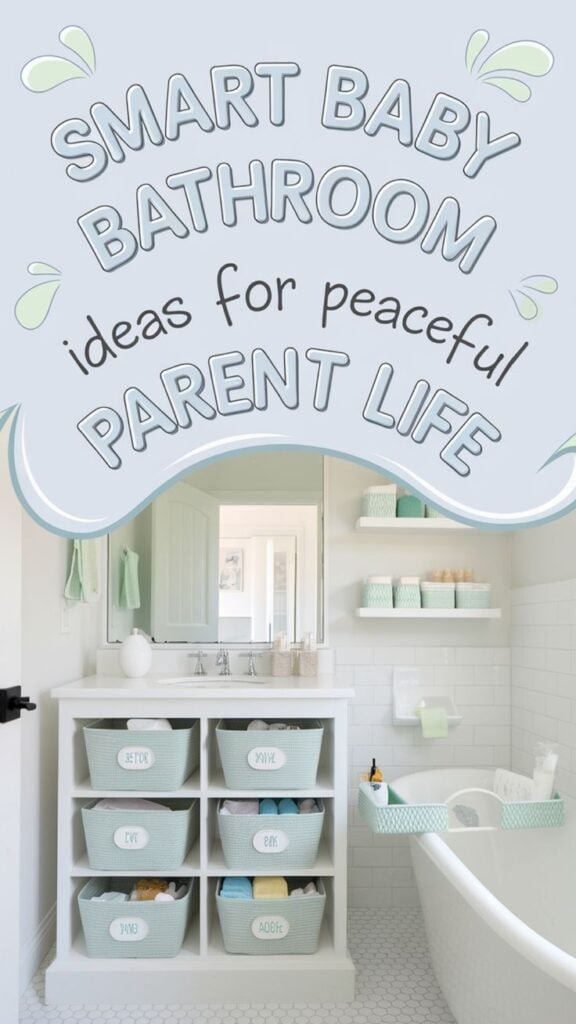
Create a Smart Bathtub Storage System
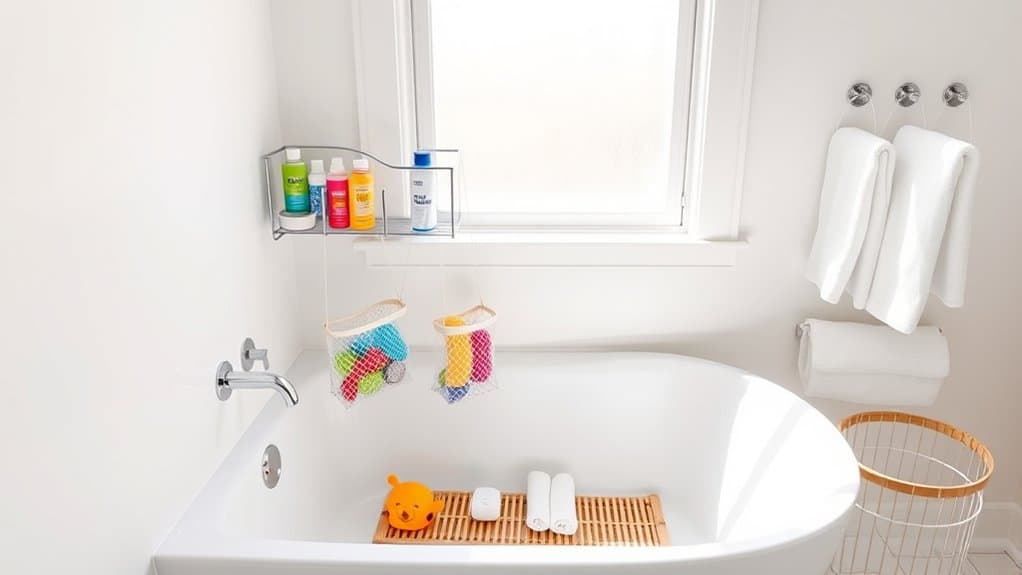
A well-organized bathtub area is crucial for making bath time safe, efficient, and enjoyable for both parent and baby. When bath supplies are properly arranged, you can keep one hand on your baby at all times while easily reaching necessary items, significantly reducing stress and potential safety risks during bath time.
Creating a smart storage system around your bathtub not only streamlines the bathing process but also helps maintain a clutter-free bathroom environment. An organized bath area means quick access to essentials, proper drainage for toys and supplies, and a more hygienic space that prevents mold and mildew buildup.
Required Items:
- Corner shower caddy or bath organizer
- Mesh bath toy organizer
- Suction cup hooks
- Bath toy storage net
- Quick-dry bath mat
- Clear storage containers
- Labels
- Command strips or hooks
- Waterproof storage basket
- Drain-friendly toy scoop
To create an effective bathtub storage system, start by mounting a corner shower caddy at adult height for potentially harmful items like soap and shampoo. Install a separate lower-level organizer for baby-specific products, ensuring it’s within arm’s reach while bathing your little one.
Position mesh organizers with strong suction cups at the end of the tub for bath toys, allowing proper drainage and preventing mold growth. Arrange frequently used items in the front and occasional-use items toward the back.
For optimal organization, establish designated zones: cleaning supplies at the top, everyday essentials in the middle, and toys at the bottom. Install hooks on the wall beside the tub for washcloths and small towels, keeping them easily accessible but away from splashing water.
Consider using clear containers with proper labeling to quickly identify contents and maintain organization.
Additional Tips:
Regularly inspect suction cups and hooks for secure attachment, and replace as needed. Implement a rotation system for bath toys to prevent overcrowding and maintain interest.
Consider using a waterproof timer or clock in the bathroom to help establish a consistent bath time routine. Clean and disinfect storage containers monthly to prevent soap scum buildup and maintain a hygienic environment for your baby’s bath supplies.
Set Up a Diaper Changing Command Center
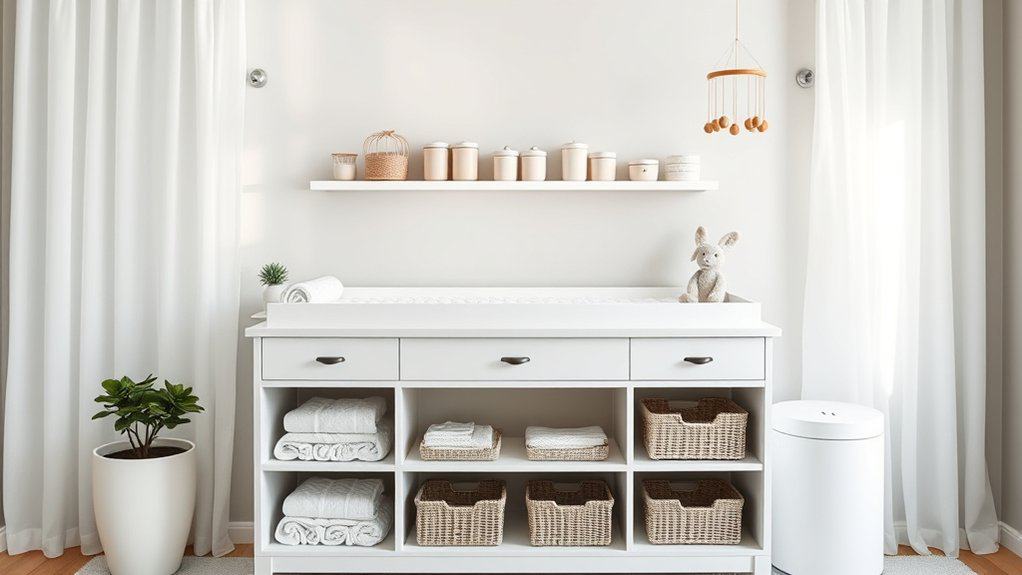
A well-organized diaper changing station serves as the cornerstone of efficient baby care, saving precious time and reducing stress during those frequent diaper changes. When everything has its designated place, parents can maintain focus on their baby while having all necessary items within arm’s reach, making the process smoother and more pleasant for both parent and child.
Creating a proper diaper changing command center not only streamlines the changing process but also helps prevent accidents and maintains proper hygiene standards. An organized station ensures that sanitizing products, fresh diapers, and clean clothes are always readily available, allowing parents to handle any situation confidently and quickly.
Required Items:
- Changing table or pad
- Diaper caddy or organizer
- Storage baskets or containers
- Diaper pail
- Wall-mounted shelving
- Drawer organizers
- Storage bins
- Labels
- Hanging organizers
- Sanitizing supplies
- First aid supplies
Start by positioning the changing table or pad in a safe, accessible location near storage space. Install wall-mounted shelving or a storage unit within arm’s reach of the changing area.
Organize supplies into clearly labeled categories: diapers and wipes in one section, clothes and burp cloths in another, and cleaning supplies in a separate, secure area. Use drawer organizers or small containers to separate items like diaper cream, powder, and other essentials. Position the diaper pail nearby for easy access while maintaining proper ventilation.
Create zones within the command center: immediate-need items at arm’s length, backup supplies in secondary storage, and occasional-use items in less accessible areas. Stock each zone appropriately, keeping frequently used items most accessible. Implement a restocking system by maintaining a designated space for backup supplies and establishing minimum quantity thresholds that trigger replenishment.
Additional Tip: Regularly audit your command center’s organization system, adjusting it based on your baby’s changing needs and your usage patterns. Consider keeping a small basket of toys or books near the changing area to entertain your baby during changes, and maintain a cleaning schedule to ensure the station remains sanitary and well-stocked at all times.
Install Space-Saving Wall Storage Solutions
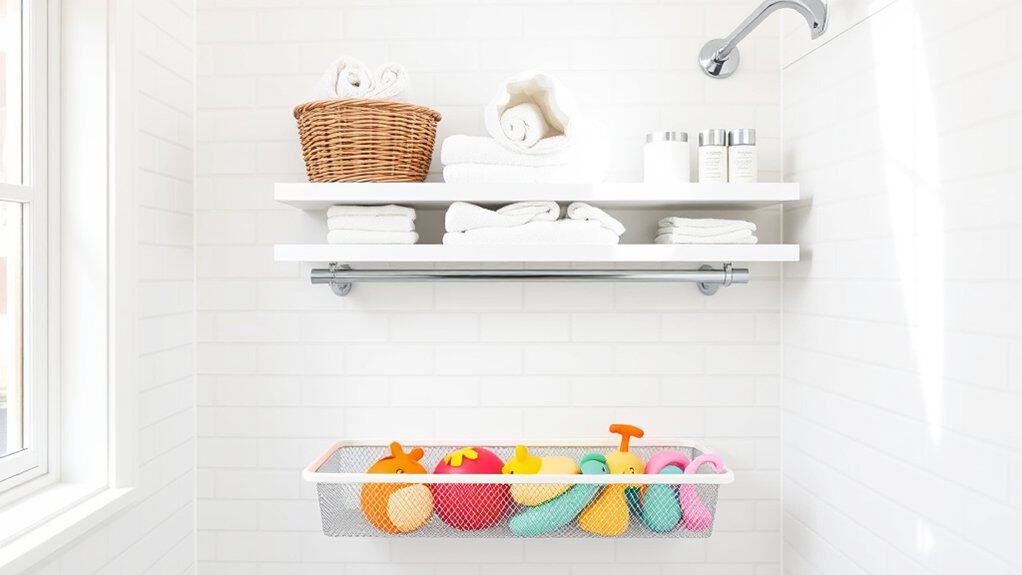
Maximizing vertical space in your baby’s bathroom is crucial for maintaining organization and accessibility of essential items. With limited counter and cabinet space, wall storage solutions can transform an overcrowded bathroom into a functional, efficient space that makes baby care routines smoother and more enjoyable.
Wall-mounted storage options not only keep items within easy reach during bath time and diaper changes but also help prevent clutter from accumulating on valuable counter space. These solutions can adapt as your baby grows, accommodating changing needs from infant care to toddler independence.
Required Items:
- Wall-mounted shelving units
- Towel bars or hooks
- Over-the-door organizer
- Storage baskets or containers
- Wall anchors and screws
- Power drill
- Level
- Measuring tape
- Pencil
- Stud finder
Begin by measuring your wall space and marking the locations for shelving units using a level and pencil. Use a stud finder to locate wall studs for secure mounting. Install the highest shelving unit first, working your way down to ensure proper spacing between elements.
Mount towel bars or hooks at a height that allows easy access while bathing baby. Position frequently used items like diapers, wipes, and bath supplies on middle shelves, keeping heavy items at waist level or below. Place decorative baskets on shelves to contain smaller items and maintain a clean appearance.
Consider safety when mounting storage solutions, ensuring all items are securely anchored and potentially hazardous products are stored out of children’s reach. Group similar items together in labeled containers, and maintain a designated spot for bath toys that allows proper drainage.
Install an over-the-door organizer for additional storage of backup supplies and less frequently used items.
To maximize your wall storage system, regularly assess and adjust the organization as your baby’s needs change. Implement a rotation system for supplies, keeping only currently needed items within immediate reach.
Consider using clear containers to easily identify contents, and establish a regular schedule for checking inventory and restocking essentials. This proactive approach helps maintain the functionality of your wall storage solution while ensuring you always have necessary items on hand.
Sort Bath Supplies by Usage Frequency

Organizing bath supplies based on frequency of use is crucial for maintaining an efficient and stress-free bathing routine with your baby. When items are properly sorted, you can quickly access daily essentials while keeping occasional-use products stored appropriately but still within reach.
Creating a frequency-based organization system saves precious time during bath sessions and helps prevent the common frustration of searching for items while keeping one hand on your baby. This system also ensures you’ll never run out of essential supplies and helps track the lifecycle of bath products more effectively.
Required Items:
- Clear storage containers
- Labels and marker
- Drawer dividers
- Shelf organizers
- Small baskets
- Waterproof bins
- Command hooks
- Storage caddy
- Clear ziplock bags
Separate all bath supplies into three main categories: daily use, weekly use, and occasional use. Place daily essentials like baby wash, shampoo, washcloths, and towels in easily accessible containers at arm’s reach from the bathing area.
Weekly-use items such as special bath toys, hair accessories, and bath treatment products should be stored in clear containers on middle shelves or in nearby drawers. Occasional-use items, including specialty products, extra supplies, and seasonal items, can be stored in labeled containers on higher shelves or in cabinet spaces further from the immediate bath area.
For maximum efficiency, implement a rotation system where nearly-empty products are placed in front of new ones, and items used together are stored together. Install a caddy or shower organizer at bath level for daily essentials, and use drawer dividers to separate items by category within each frequency group.
Additional Tip: Review and adjust your organization system every three months to ensure it still meets your baby’s changing needs. Remove outgrown items, check expiration dates, and reorganize supplies as your baby’s bathing routine evolves.
Consider keeping a small inventory list inside a cabinet door to track supplies and make restocking easier.
Design a Safe Baby Medicine Station
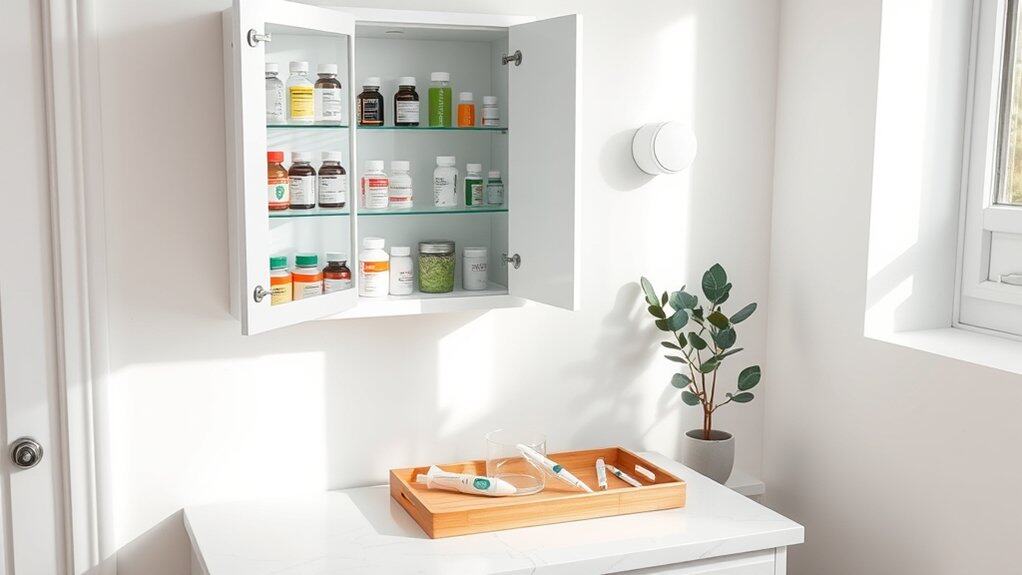
Creating a well-organized baby medicine station is crucial for managing your infant’s health needs efficiently and safely. A properly arranged medicine area ensures quick access during late-night emergencies while maintaining strict safety protocols to prevent accidents or misuse.
The right organization system helps parents track medication expiration dates, maintain proper storage conditions, and keep essential items readily available. This structured approach reduces stress during illness and ensures all caregivers can locate necessary items quickly while maintaining child safety standards.
Required Items:
- Lockable medicine cabinet or box
- Clear storage containers
- Label maker or labels
- Temperature monitor
- Medicine droppers and syringes
- Small measuring cups
- Digital thermometer
- Medicine log notebook
- Child-proof locks
- Drawer dividers
- First aid supplies
The organization process starts with installing a lockable cabinet at adult height, well out of children’s reach. Sort medications by category (fever reducers, cold medicines, first aid) and place them in clear, labeled containers.
Create a designated space for measuring tools and ensure they’re cleaned after each use. Install a small whiteboard or medicine log inside the cabinet door to track doses and schedules.
For maximum effectiveness, arrange items with most frequently used medications at eye level and emergency items in a clearly marked section. Store temperature-sensitive items away from bathroom heat and humidity.
Use drawer dividers to separate measuring tools, and maintain a clear inventory system with expiration dates clearly visible on all items.
Additional Safety Tips: Regularly audit medicine supplies every three months, disposing of expired medications properly through authorized facilities. Create a backup emergency kit for travel, and maintain a current list of emergency contacts and your pediatrician’s number inside the cabinet.
Consider installing motion-sensor lighting near the station for better visibility during nighttime access, and always keep the safety lock engaged when not in use.
Establish a Quick-Dry Towel and Washcloth Zone
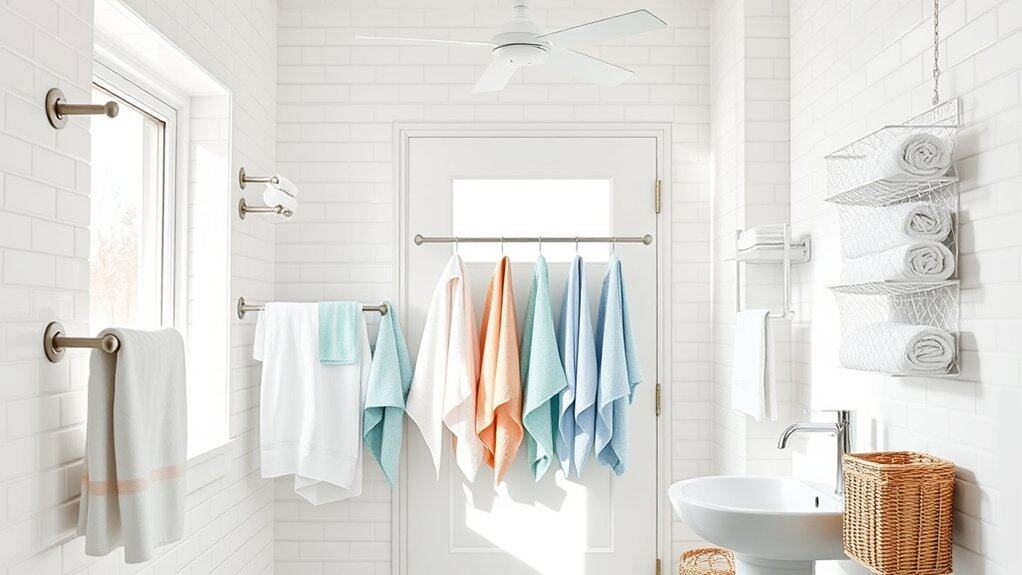
A well-organized towel and washcloth zone is essential for efficient baby care, especially during bath time when you need quick access to clean, dry items while keeping one hand on your little one. Proper organization of these essentials not only streamlines your routine but also ensures that linens dry thoroughly between uses, preventing mildew and bacterial growth.
Creating a dedicated quick-dry zone helps maintain hygiene standards while making daily tasks more manageable. When towels and washcloths are properly arranged and allowed to dry efficiently, they remain fresh longer and are always ready for your baby’s next bath or cleanup session.
Required Items:
- Over-door towel rack
- Wall-mounted towel bars
- Command hooks
- Mesh hanging organizer
- Small laundry basket
- Label maker
- Moisture-resistant bins
- Quick-dry towel hooks
- Air circulation fan (optional)
- Waterproof labels
Mount the towel bars or hooks at an accessible height, ensuring adequate spacing between items for proper air circulation. Install the over-door rack for additional hanging space, and position the mesh organizer nearby for clean washcloth storage.
Designate separate zones for clean and used items, with the laundry basket placed in an easily accessible spot for soiled linens. Create a rotation system where wet items can hang without touching, allowing for maximum airflow and faster drying times.
Label each storage area clearly to maintain organization, especially if multiple caregivers are involved. Consider using color-coding for different types of items (bath towels, washcloths, hand towels) to make the system more intuitive. Position items based on frequency of use, keeping daily essentials at arm’s reach while storing backup supplies in moisture-resistant bins.
Additional Tips: Implement a daily check of the quick-dry zone to ensure proper air circulation and prevent forgotten wet items. Consider installing a small fan for enhanced ventilation in humid climates.
Rotate items regularly to prevent wear in specific spots, and maintain a stock count to ensure you never run low on clean linens. Remember to sanitize hooks and bars weekly to maintain a hygienic environment for your baby’s bath items.
Organize Baby Toiletries With Clear Containers
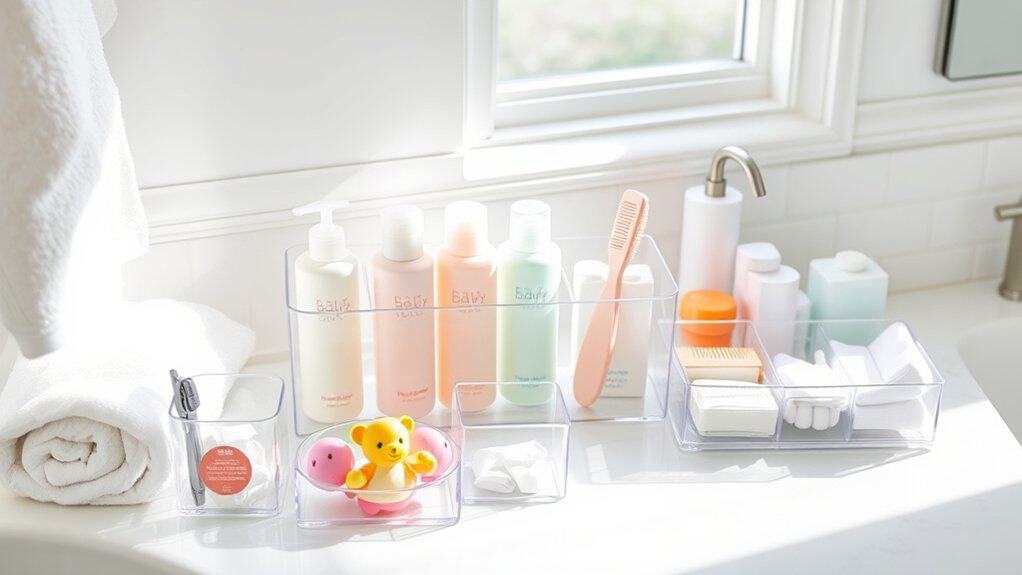
Keeping baby toiletries organized in clear containers is essential for maintaining a functional and stress-free bath time routine. When items are visible and easily accessible, parents can quickly grab what they need while keeping one hand on their little one, making bath time safer and more efficient.
Clear containers not only provide instant visibility but also protect baby products from bathroom moisture and help maintain cleanliness. This organization system allows parents to quickly inventory supplies, identify when items need restocking, and ensure that all necessary bath time products remain within arm’s reach.
Required Items:
- Clear acrylic containers in various sizes
- Container labels or label maker
- Drawer dividers
- Small basket organizers
- Clear storage bins with lids
- Shelf liner
- Measuring tape
- Cleaning supplies
Start by measuring your available storage space and selecting appropriately sized clear containers. Sort baby toiletries into categories: bath products (shampoo, soap, lotion), medical supplies (thermometer, nail clippers), daily care items (brush, comb), and bath toys.
Place similar items together in containers that fit their size and frequency of use. Position frequently used items at eye level or in easily accessible locations.
Label each container clearly to maintain organization and help other caregivers locate items quickly. Use drawer dividers for smaller items like medicine droppers or thermometers. Store backup supplies in larger clear containers with lids on higher shelves or under the sink.
Consider using stackable containers to maximize vertical space and maintain a clean appearance. To maintain this organization system, regularly assess the contents of each container, dispose of expired products, and clean containers monthly.
Consider implementing a rotation system for backup supplies to ensure older products are used first. Keep a small basket of daily essentials separate from the main storage for quick access during rushed moments or middle-of-the-night needs.


